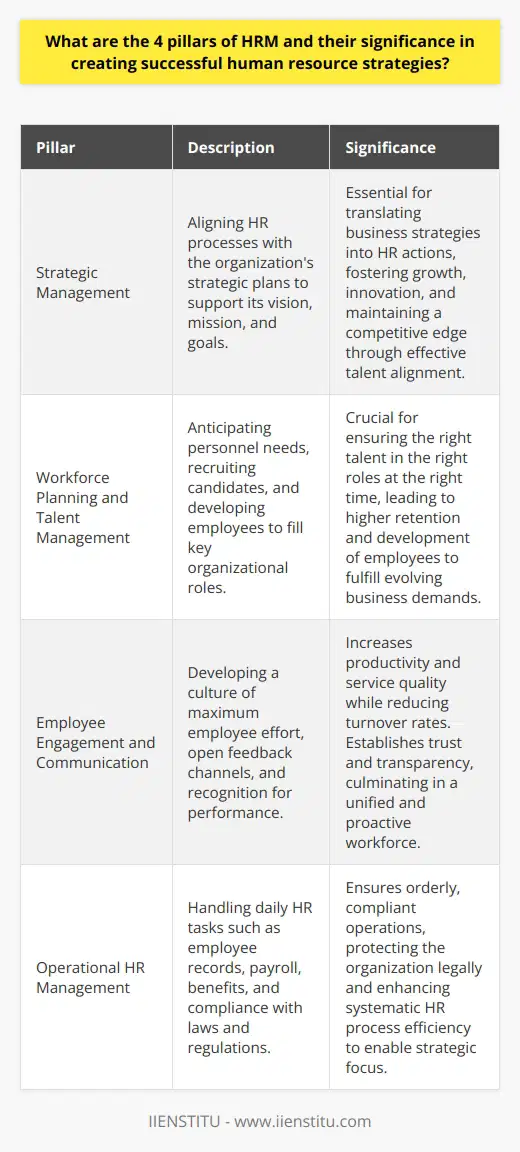
Human resources management (HRM) is a critical function for all organizations. After all, HRM is responsible for attracting, developing, and retaining talent within an organization. But what exactly are the key functions of HRM? Let's take a closer look.
The 4 Key Functions of HRM: What They Are and Why They Matter
Learn the four key functions of HRM and what they mean for your business.
Understand why each function is important and how they work together to help your company run smoothly.
Gain insight into how HRM can help you manage your employees more effectively.
Get tips on how to optimize each function to get the most out of your HR department.
The Recruitment Function
One of the most important functions of HRM is recruitment. This is the process of sourcing and selecting individuals to fill vacant positions within an organization. The recruitment function is important because it ensures that the right people with the right skills are hired to do the job.
For example, if your company sells specialized medical equipment, you need to hire salespeople who have the knowledge and experience necessary to sell these products. Without a recruitment function, you may end up hiring people who are not a good fit for the position or who do not have the right skills.
The Training and Development Function
Another key function of HRM is training and development. This refers to the process of providing employees with the skills and knowledge they need to do their jobs effectively. Training and development helps to improve employee productivity and performance and can also help to reduce turnover.
For example, if a new salesperson starts working for your company, he or she may not have much experience with your specific products. By providing training and development opportunities, the employee can quickly gain the skills and knowledge needed to be successful in their role.
The Compensation and Benefits Function
Another important function of HRM is compensation and benefits. This refers to the process of designing and administering salary, bonus, and benefit programs that attract, motivate, and retain employees. The compensation and benefits function is important because it helps to ensure that employees are fairly compensated for their work and that they have access to quality benefits.
For example, if your company wants to keep its employees happy and engaged, it might offer generous bonuses or provide access to a 401(k) plan. By understanding the compensation and benefits function, you can determine which programs are right for your organization and design an effective rewards program.
The Employee Relations Function
The final key function of HRM is employee relations. This refers to the process of managing the relationship between an organization and its employees. Employee relations includes activities such as communication, conflict resolution, employee engagement, and workforce planning. The employee relations function is important because it helps to ensure that employees are satisfied with their jobs and that they are able to contribute effectively to the organization.
For example , if an employee has a problem with their supervisor or manager, an effective employee relations function will help to address the issue quickly and fairly.
Overall, the four key functions of HRM are essential for any organization. By understanding each function and how it works within your business, you can optimize HR practices and get the most out of your HR department. Ultimately, this will help to improve productivity, performance, and engagement throughout your organization.
To sum up, the four key functions of HRM are: Planning, Recruitment and Selection, Training and Development, and Employee Relations. Each function is important in its own right and plays a vital role in the successful running of any organization. Of course, there is much more to HRM than these four functions but they provide a good foundation on which to build your knowledge. If you want to learn more about HRM and how to effectively manage a team of staff, join our HR management course.

Frequently Asked Questions
What is the recruitment and selection function of HRM?
The recruitment and selection function of HRM refers to the process of finding, attracting, and hiring new employees. This can involve activities such as posting job opportunities online or in local newspapers, screening applications, interviewing candidates, and making final hiring decisions. Key considerations for effective recruitment and selection include assessing candidate qualifications, identifying potential cultural fits within your organization, and ensuring that you have adequate resources to support new hires.
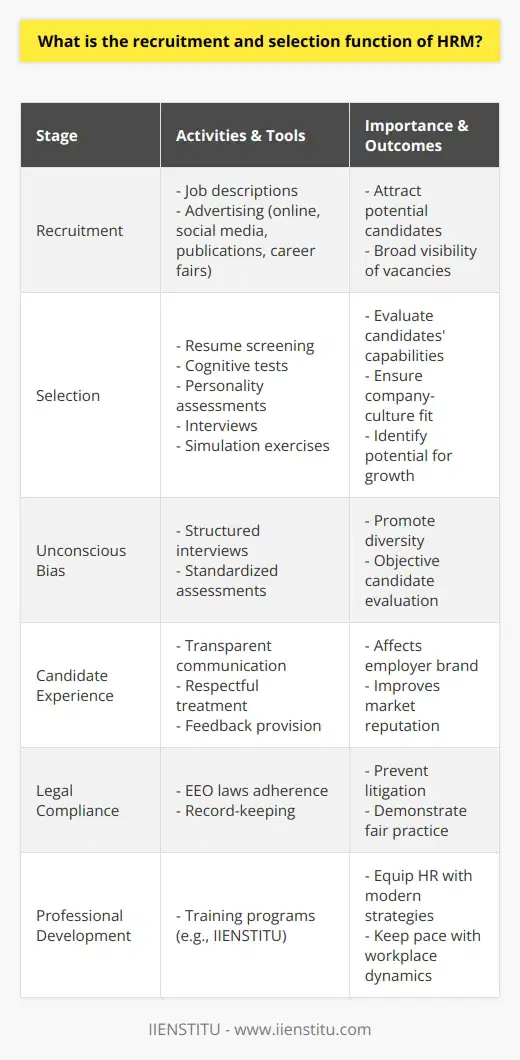
What is training and development in HRM?
Training and development is another key function of HRM that involves providing employees with the skills and knowledge they need to do their jobs effectively. Activities may include on-the-job training, coaching and mentoring, career development programs, and professional development workshops. Key considerations for effective training and development include assessing employees' current skill levels and identifying areas where they could use additional support or training.
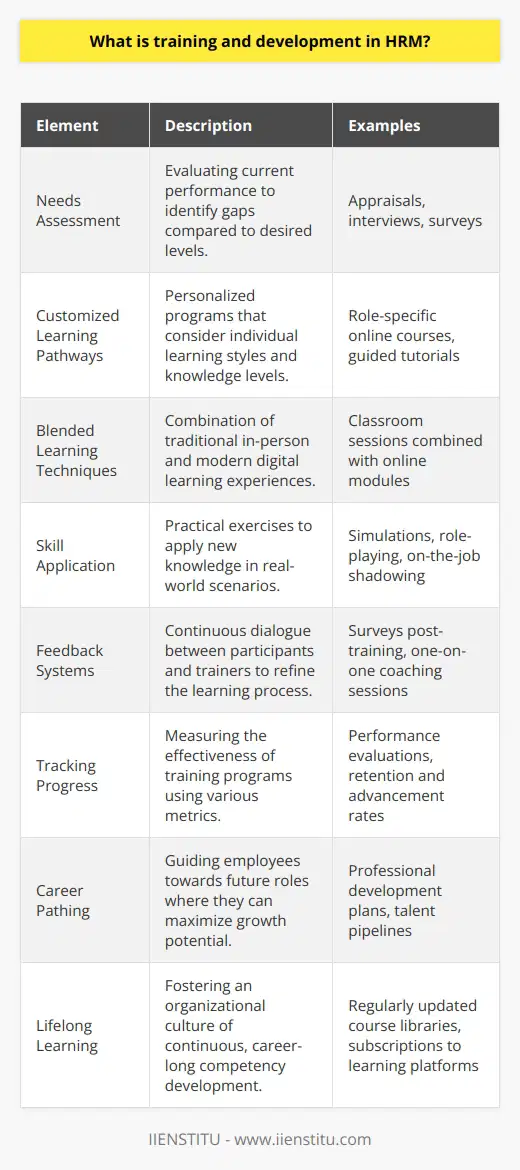
What is employee relations in HRM?
Employee relations refers to the process of managing relationships between employers and employees, including communication, conflict resolution, engagement efforts, and workforce planning. This can involve activities such as listening to employee feedback and concerns, implementing policies that promote positive work environments, resolving conflicts effectively, and implementing strategies for improving engagement among all employees.
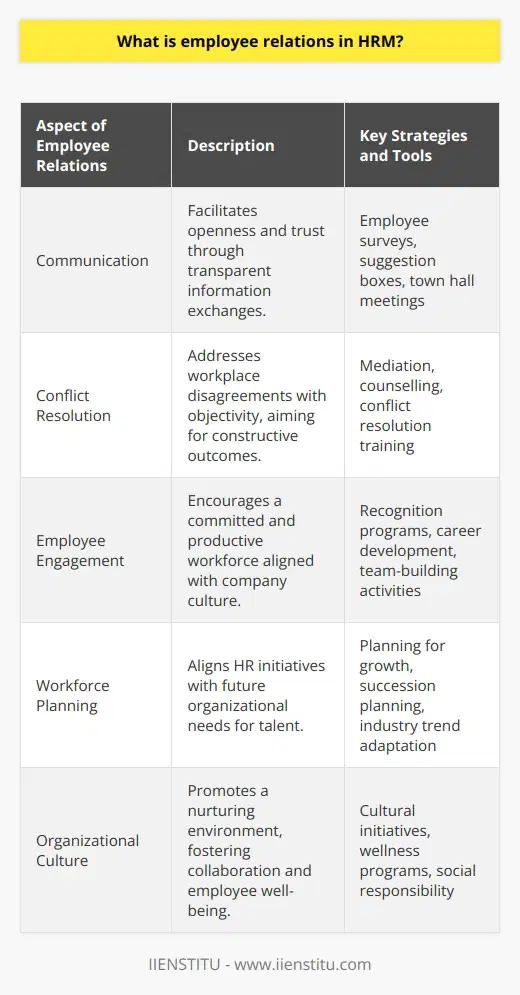
How does HRM help ensure compliance with labor laws and regulations?
HRM helps ensure compliance with labor laws and regulations by providing guidance and tools to help managers understand their legal responsibilities and duties. HR professionals can help managers understand what laws and regulations apply to their specific operations and provide guidance on how to comply with them. They can also provide training on legal topics such as workplace safety, employee discrimination, and wage and hour laws. Additionally, HR can create and implement policies and procedures to ensure compliance with applicable laws and regulations.

What strategies can be used to improve employee engagement and morale?
Offer flexible working hours and work-from-home options.
Offer meaningful incentives, such as company-sponsored outings and rewards for exceptional performance.
Provide employees with interesting and challenging tasks to complete.
Hold regular team-building activities, such as company picnics, potlucks, and holiday parties.
Listen to employee feedback and take it into account when making decisions.
Celebrate successes, both big and small.
Invest in employee development and training opportunities.
Demonstrate appreciation for employees by recognizing their hard work.
Create an open, positive work environment that encourages collaboration.
Encourage healthy work-life balance by providing access to mental health resources.

How can HRM help to ensure the organization is achieving its goals?
HRM can help to ensure an organization is achieving its goals by recruiting, training and developing employees to ensure they are equipped with the skills and knowledge necessary to support the organization's goals. HRM can also help to develop policies and procedures to ensure the organization is operating within the scope of its goals and objectives, and by providing recognition and rewards to those individuals and teams who contribute to the organization's success. Additionally, HRM can provide support and guidance to employees to ensure their roles within the organization are aligned with the organization's goals.

What is the role of HRM in creating and maintaining a positive organizational culture?
Role of HRM in Shaping Culture
Human Resource Management (HRM) plays a pivotal role in shaping and sustaining a positive organizational culture. HR professionals first establish this culture by identifying and introducing positive values during the recruitment process.
Building a Positive Culture
By emphasizing organizational values and expected behavior during interviews, they signal candidates about the prevalent culture. Post recruitment, they orient new employees, detailing the organizational values and expectations. Regular training sessions further reinforce these values.
Maintaining a Positive Environment
HRM maintains a positive environment through consistent reinforcement and rewards. Reward systems present a strong mechanism to underscore desired behaviors. Likewise, disciplinary procedures buttress the culture by highlighting unacceptable behaviors.
Culture Communication
HRM also serves as culture communicators. They repeat, clarify and reinforce the definitions of exemplary behavior, thereby promoting a commendable culture. By intervening when deviations occur, they help protect and preserve the positive culture.
Employee Engagement
Additionally, HRM regularly works on employee engagement activities, building relationships and team spirit. This nurtures a sense of belonging and complies with the organizational culture.
Change Management
Finally, under change management, HRM works to reposition organizational culture. Changes can cause anxieties and make employees resistant. HRM minimizes such concerns through transparent communication and earlier involvement of employees in decision-making.
In conclusion, HRM is key in creating and maintaining a positive organizational culture. Through various roles like culture shaping, reinforcement, change management and more, HRM contributes to a conducive work environment.
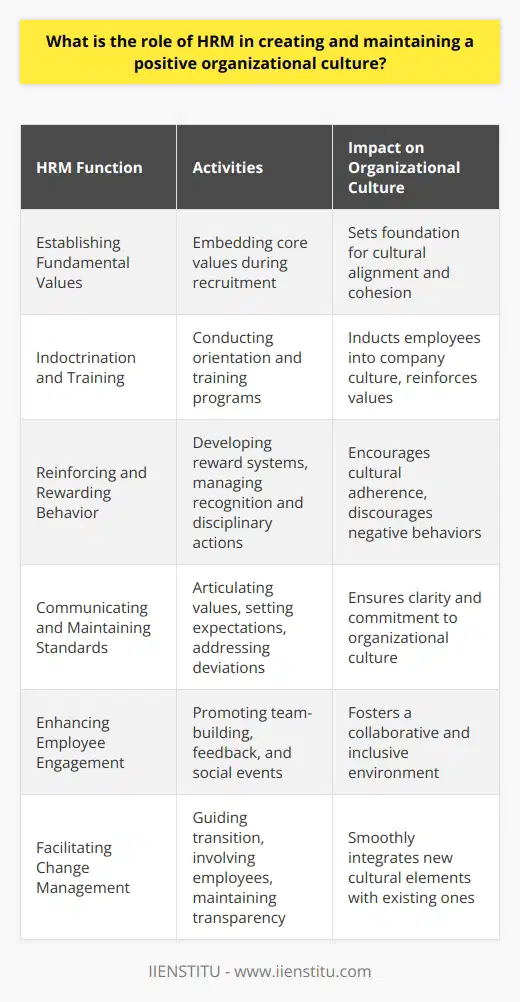
How does HRM contribute to the strategic planning and execution within an organization?
Contributions of HRM to Strategic Planning
Human Resource Management (HRM) plays a significant role in the strategic planning within organizations. The primary contribution of HRM is aligning strategic goals with employee performance. HRM systematically plans human resources needs, allowing organizations to anticipate and structure their workforce optimally.
HRM and Setting Strategic Goals
Setting strategic goals is an important aspect of business planning. HRM contributes to this by identifying talent within the organization that can be leveraged to achieve these goals. At the same time, HRM ensures the organization has adequate staffing with the necessary skills.
HRM in Execution of Strategy
HRM not only participates in planning strategy but also oversees its execution. HRM uses performance management systems to assess employee output. Constant monitoring of these systems enables HRM to identify performance gaps and take corrective action. Moreover, HRM develops training programs to enhance workers' skills, boosting productivity to meet strategic objectives.
HRM Facilitates Communication
HRM contributes to strategy implementation through effective communication. It helps to convey the organizational vision, mission, and strategies to all stakeholders. Clear and transparent communication ensures that all staff understand the strategic goals, fostering a cooperative environment.
HRM's Role in Organizational Culture
Lastly, HRM helps to cultivate an organizational culture that encourages strategic success. It aids in establishing an organizational culture that is aligned with the company's strategic goals. HRM achieves this through selecting, training, motivating, and retaining the right talent.
In conclusion, HRM's contribution to strategic planning and execution is invaluable. It ensures businesses are well equipped to achieve their strategic goals, helping them remain competitive. Therefore, organizations should understand the importance of HRM and invest in it accordingly.
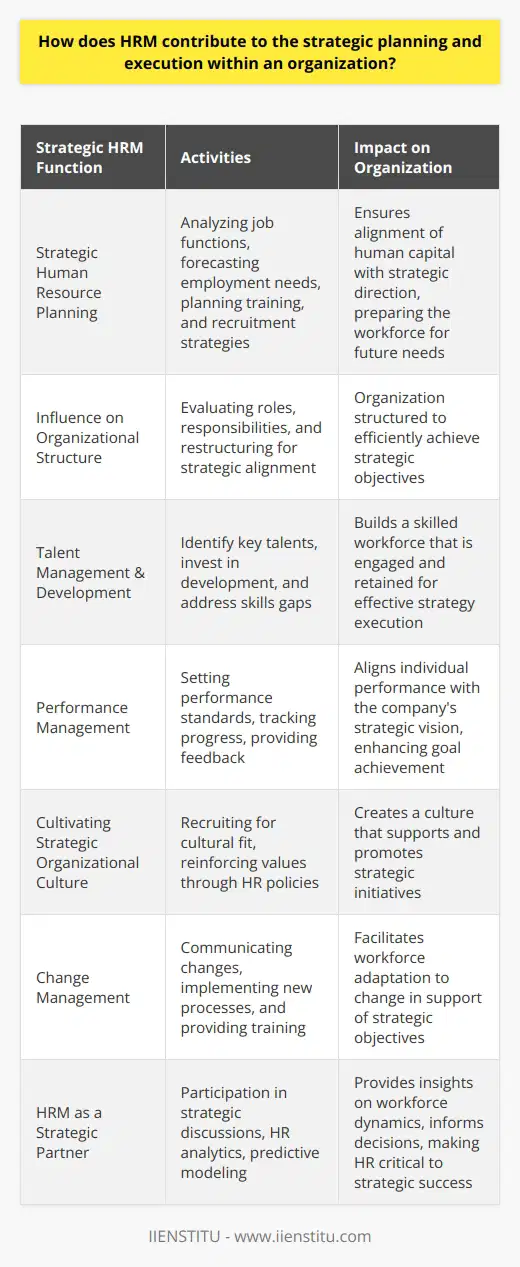
In what ways can HRM support and promote diversity and inclusion in the workplace?
Strategies for HRM to Encourage Diversity and Inclusion
Human Resource Management (HRM) plays a crucial role in creating organizational inclusivity. Implementing diversity and inclusion policies is one method. Comprehensive policies ensure equitable treatment for all employees, preventing discrimination and promoting diversity.
Effective Recruitment and Hiring
HRM can ensure diversity right from the recruitment stage. By adopting fair and unbiased hiring strategies, they secure a diverse range of candidates, creating a multicultural workforce.
Diverse Employee Training
Training programs help employees comprehend the importance of diversity and inclusion. These increase awareness and mutual respect among the team. HRM evaluating and revising training programs regularly ensures their effectiveness.
Workplace Cultural Enhancement
HRM can foster an inclusive culture by celebrating various cultural norms and customs. Encouraging employees to share their traditions creates a respectful and welcoming environment.
Constructive Communication Channels
Encouraging open communication, HRM promotes inclusion. They can offer platforms for employees to express ideas, concerns and celebrate diversity.
Support Networks and Mentorship
HR can also establish support networks and mentorship programs. These encourage knowledge sharing, collaboration, and nurture inclusion.
Recognition and Rewards
Instituting recognition and reward systems for employees who embrace diversity is another HRM strategy. This encourages a diverse and inclusive workplace.
In conclusion, HRM has multiple areas to promote diversity and inclusion in the workplace. By focusing on policies, hiring, training, culture, communication, support networks, and rewards, they influence a progressive work environment.
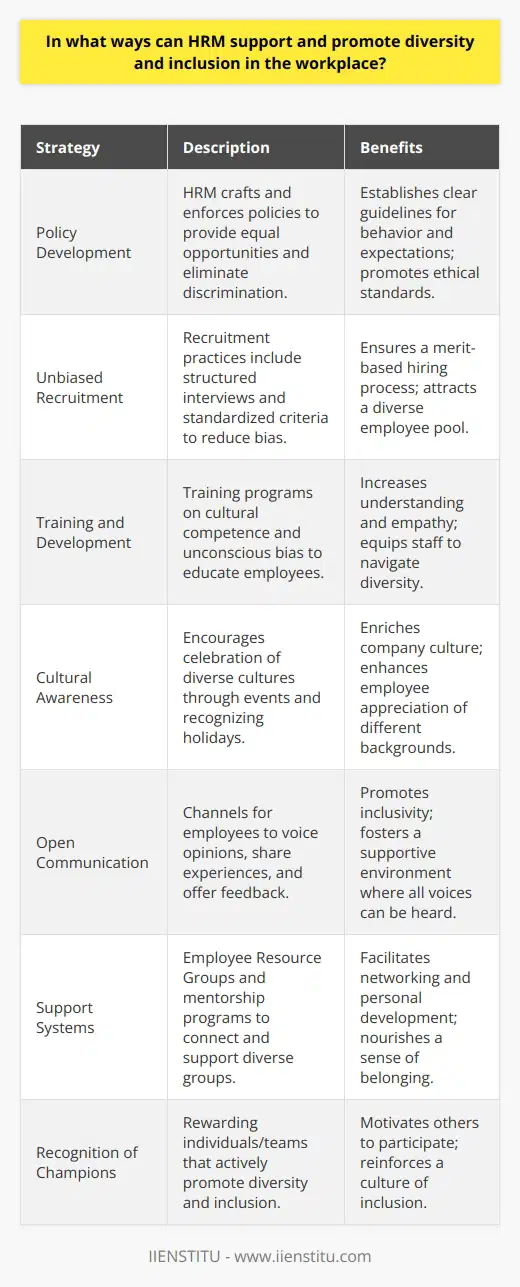
What are the key functions of HRM in managing organizational change and development?
HRM Role in Organizational Change
Human Resource Management (HRM) plays a vital role in managing organizational change and development. The key functions of HRM include identifying the need for change, planning, and implementing change strategies.
Identifying Change Requirement
HRM recognizes the business scenario that warrants change. This can be due to various factors including competition changes, leadership changes, or market dynamics. HRM undertakes a careful assessment of the prevailing situation to determine the critical areas requiring change.
Change Planning
HRM is pivotal in planning the change process. HRM prepares a detailed roadmap outlining the stages of change. The process involves setting change objectives, defining the roles of different team members, and establishing a timeline to achieve this.
Implementation
HRM oversees the implementation of change strategies. It not only executes the planned approach but ensures that everyone in the organization understands the reasons and benefits of change. HRM takes responsibility for communicating change to the entire organization.
Assessing Readiness for Change
To guarantee a smooth transition, HRM gauges the organization's readiness for change. This includes assessing employees' willingness, the present skills set, and the ability to adapt to the proposed changes.
Training and Development
One of the critical roles HRM plays is organizing training and development programs. HRM plans these sessions to equip the team with the necessary skills to handle new tasks resulting from change.
Addressing Resistance
Change often triggers resistance. HRM identifies and addresses sources of resistance, ensuring that the organization and its individuals move along the change path together.
Maintaining Stability Post-Change
Lastly, post-change, HRM's role is to ensure stability within the organization. This involves the assessment of changes' efficiency, identification of areas for improvement, and successive tweaking of change measures, if necessary.
In conclusion, HRM acts as a facilitator for change, engages employees, builds readiness for change, deals with resistance, and ensures a smooth transition. It's crucial for organizations to recognize and utilize the potential of their Human Resources to drive and manage organizational change.

How does HRM address workplace health and safety concerns to promote employee well-being?
Ensuring Safe Work Environment
Human Resources Management (HRM) plays a key role in ensuring the health and safety of employees. They establish a comprehensive safety framework. The framework outlines rules, regulations, expectations, and guidelines. It aims at preventing accidents and injuries.
Health and Safety Training Programs
HRM also conducts health and safety training programs. These programs raise employees' consciousness about safety norms. They teach workers the best and safest practices to use. Training collaboratively creates a safety-conscious work culture across the organisation.
Risk Assessment and Control
Risk assessment is another significant step. HRM identifies potential hazards in the workplace. In turn, they plan and implement strategies to control these risks. This process reduces the likelihood of injuries and accidents.
Promoting Employee Well-being
Furthermore, HRM promotes employee well-being. They stress the importance of a balanced work-life schedule. HRM can enforce policies promoting physical activities. They can provide mental health support for stress management. Such measures are essential in promoting the holistic well-being of employees.
Employee Assistance Program
Many organisations have Employee Assistance Programs (EAP). HRM ensures the smooth functioning of EAP. It helps employees to address personal issues deteriorating their productivity and well-being.
Reporting and Investigation of Incidents
Incident reporting and investigations also fall under HRM. They promptly address any reported safety issues. Investigations of the incidents help in understanding their root causes. Accordingly, they devise strategies to prevent future occurrences.
Enhancing the Employer-Employee Relationship
Finally, HRM plays a vital role in nurturing the employer-employee relationship. They address the employees' concerns effectively, fostering trust within the organization. This trust strengthens the belief among employees about their employer's commitment to safety. Thus, HRM assures employees about their safety, which in turn enhances their productivity. Therefore, HRM' role in promoting workplace health and safety is pivotal. Healthy and safe employees are productive employees. Thereby, HRM significantly contributes to the overall success of an organisation.
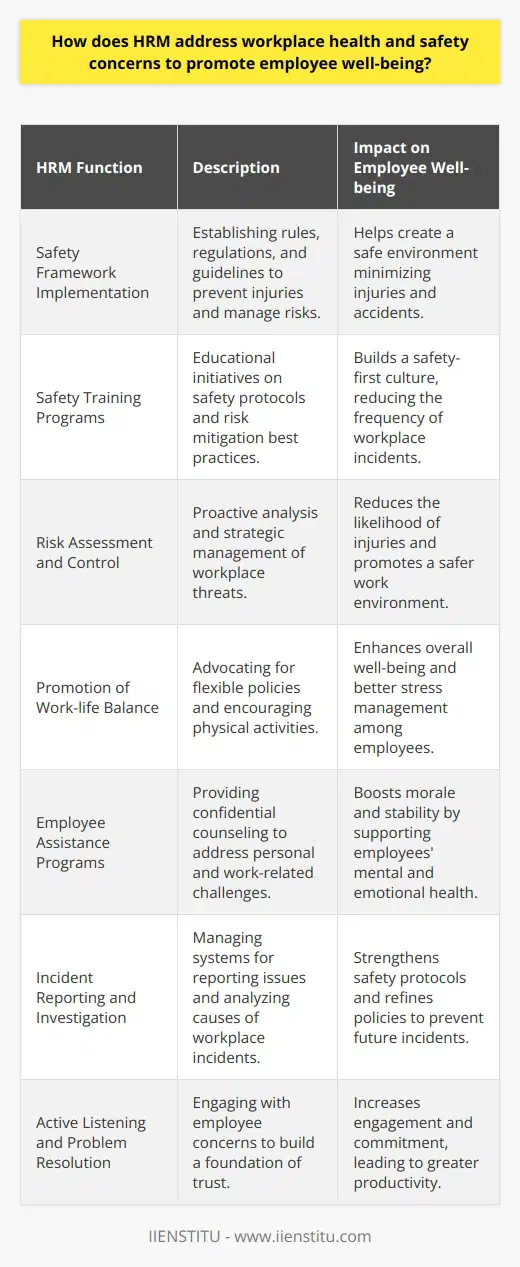
What role does HRM play in performance management and employee evaluations?
Role of HRM in Performance Management
Human Resource Management (HRM) fundamentally shapes performance management systems. It ensures the alignment of employee performance with organizational goals. HRM designs performance metrics, sets KPIs, and maps the road to achievement.
Formulating Performance Criteria
The first step HRM takes is creating performance criteria. These standards serve as the basis for assessing employees' work. HRM ensures they align with the organization's strategic objectives.
Setting Goals and Measures
HRM also establishes goals and the ways to measure them. This step is crucial in maintaining objectivity in the evaluation process. Consistency in measures helps enhance fairness and transparency.
Monitoring and Evaluation
HRM's role does not end at setting goals. Regular monitoring and evaluation are essential duties. This step involves the constant review of performance against the set criteria.
Providing Feedback and Recognition
HRM expertly handles feedback and recognition, which are core in enhancing employee motivation. They offer constructive feedback and appropriate recognition to enhance employee engagement and commitment.
Role in Employee Evaluation
HRM plays a critical part in employee evaluations. This process involves assessing each worker's performance and contribution to the company. HRM conducts these evaluations to identify areas of improvement, enhance productivity and promote talent.
Developing Evaluation Techniques
HRM devises various evaluation techniques. They work to ensure fair and unbiased evaluations, incorporating a blend of self-assessment and peer rating alongside supervisor appraisals.
Addressing Performance Issues
Another essential role of HRM in employee evaluation lies in addressing performance issues. HRM devises strategies to help underperforming employees improve, maintaining the focus on personal growth and development.
Promoting Talent
Lastly, HRM uses evaluations to identify and promote talent within the organization. They ensure deserving employees get the appropriate reward for their efforts, facilitating leadership development.
In conclusion, HRM plays an integral role in performance management and employee evaluations. They design the systematic processes, ensuring alignment with organizational goals, and facilitate employee development and growth.
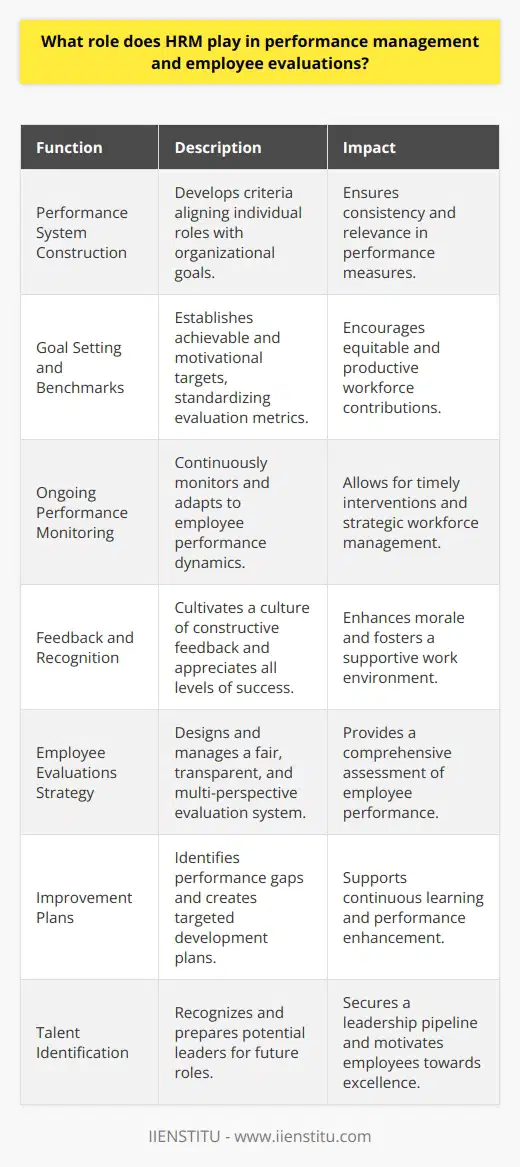
What are the 4 main functions of HRM?
Staff Recruitment and Selection
One crucial function of Human Resource Management (HRM) is staff recruitment and selection. It involves defining job descriptions, publicizing vacancies, vetting applicants, coordinating interviews, and finally selecting the right candidate.
Employee Training and Development
Another function is employee training and development, which leads to cultivating a skilled workforce. Not only targeted at new hires, this function provides ongoing development opportunities to ensure that staff possess current skills crucial to their roles.
Employee Performance Management
The HRM also takes on the role of employee performance management. Here, it formulates strategies to monitor and evaluate job performance. It gives feedback to employees, rewarding excellence, and addressing under-performance.
Workplace Safety Compliance
Moreover, HRM ensures workplace safety compliance. It demands knowledge of safety laws and the capacity to develop protective measures in the workplace. HRM thus operates to minimize risk and maintain a safe work environment for all employees.
In conclusion, from recruitment to training, performance management, and workplace safety, HRM fulfills several strategic roles. It helps organizations recruit, retain, and develop a committed and competent workforce, while ensuring a safe workplace and adherence to employment laws.
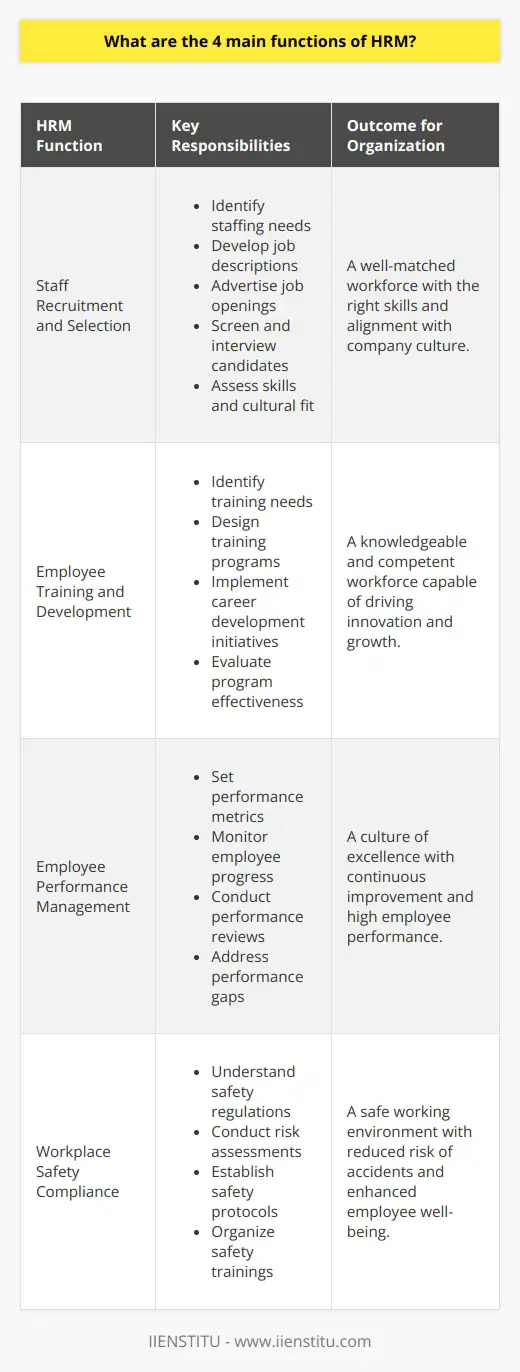
How do the key functions of HRM impact organizational effectiveness and employee satisfaction?
Impact on Organizational Effectiveness
HRM (Human Resource Management) greatly impacts an organization's effectiveness. Recruitment and selection, one of HRM's primary functions, ensures companies attract and retain high-performing employees. This contributes to the achievement of the organization's broader goals.
Role in Employee Satisfaction
Employee satisfaction levels also heavily relate to HRM practices. HRM assesses employee needs and strives to meet them. This includes career development opportunities, decent compensation, and constructive feedback. Satisfying these needs results in increased employee motivation and, subsequently, better performance.
Influence on Training and Development
Another key function of HRM, training and development, enhances organizational effectiveness. Regular training equips employees with the necessary skills to perform their tasks efficiently. Moreover, development opportunities encourage employees to grow professionally, which leads to increased job satisfaction.
Importance in Performance Management
Performance management is another crucial function of HRM impacting overall organizational effectiveness and employee satisfaction. Effective performance management systems ensure employees understand their roles and expectations, leading to improved job performance. Regular feedback keeps employees engaged and satisfied.
Effect on Employee Retention
HRM plays a crucial role in employee retention. An employee-friendly work culture, adequate compensation, and growth opportunities are essential for retaining employees. High retention rates contribute to organizational stability and productivity, directly impacting the overall effectiveness and employee satisfaction.
Conclusion
In conclusion, the key functions of HRM substantially impact the effectiveness of an organization and the satisfaction of its employees. Successful HRM practices result in a competent and satisfied workforce, directly affecting an organization's overall productivity and success.
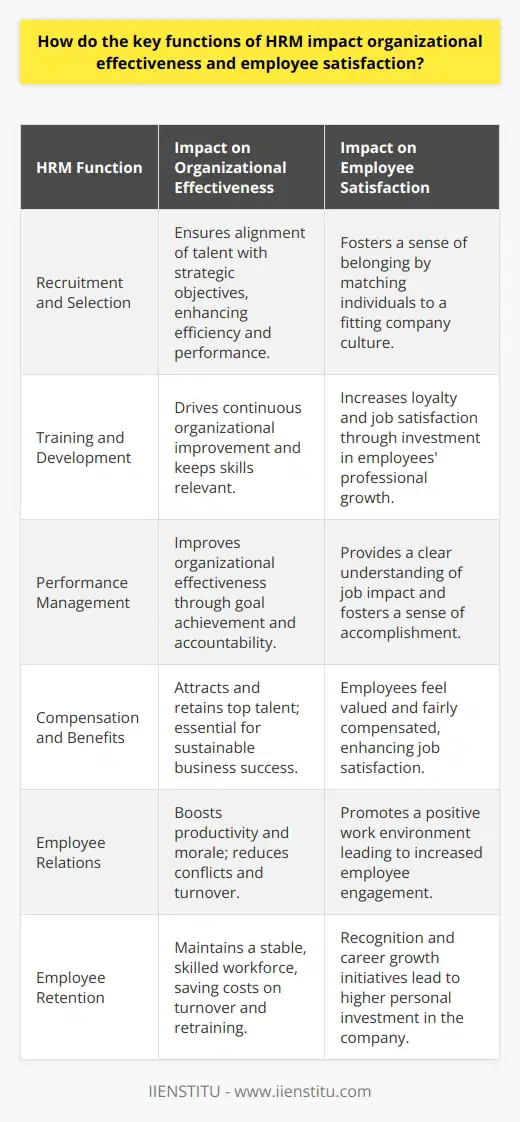
What are the 4 pillars of HRM and their significance in creating successful human resource strategies?
Pillar 1: Strategic Management
Strategic management serves as the first pillar of Human Resource Management (HRM). It grounds HR tasks stem from broader organizational objectives. Through this lens, HR professionals create and implement human resource strategies enabling the organization to reach its goals. They deeply align HR policies and practices with the establishment's overall strategy.
Pillar 2: Workforce Planning and Talent Management
The second pillar is workforce planning and talent management. It involves hiring the right people for the right roles at the right time. HR professionals must proactively address succession planning, career development, retention strategies, and talent gaps. Implementing this pillar successfully assures a capable and engaged workforce, promoting optimal organizational productivity.
Pillar 3: Employee Engagement and Communication
Employee engagement and communication, the third pillar, directly influence workforce motivation and retention. HR departments must foster a positive organizational culture by encouraging open communication, providing regular feedback and recognizing employees' efforts. A culture of engagement translates to dedicated employees, increased enthusiasm, and improved team performance.
Pillar 4: Operational HR Management
Operational HR Management serves as the fourth pillar. It involves day-to-day operational tasks such as processing payroll, administering benefits, and maintaining compliance. Keeping a keen eye on these routine administrative tasks ensures legal compliance minimizing potential litigation risks, thus safeguarding the organization's reputation.
In summary, these four pillars of HRM are crucial for creating successful human resource strategies. They serve as a roadmap, guiding HR professionals towards practices that align with organizational goals, optimize workforce potential, promote positive culture, and ensure the effective management of administrative operations. Implementing these pillars strategically and consistently can significantly boost organizational performance, productivity, and sustainability.
